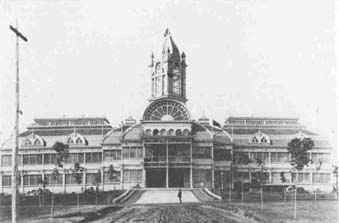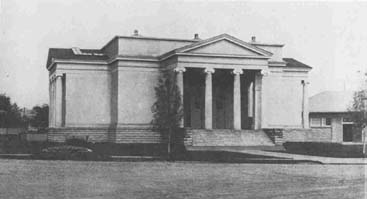
Bulletin 22, 1973
Home
Français
Introduction
History
Annual Index
Author &
Subject
Credits
Contact

![]()

Foreign
Art at the Canadian National Exhibition 1905-1938
by Sybille Pantazzi
Résumé en français
Pages 1 | 2 |
3 | 4
| 5 | 6
| 7 | 8
| 9 | 10
| 11
Author's note:
The abbreviations for
institutions referred to throughout this article are listed here.
A. G. O. Art Gallery of Ontario
A. G. T. Art Gallery of Toronto
C. N. E. Canadian National Exhibition
C. N. E. (D. F. A.) Canadian National Exhibition (Department of Fine
Arts)
C. W. M. Canadian War Memorials
M. T .C. L. Metropolitan Toronto Central Library O. S. A. Ontario
Society of Artists
O. S. A. (A. R.) Ontario Society of Artists (President's [Annual]
Report)
R. C. A. Royal Canadian Academy
Today the idea of the superior status of the avant-garde still
holds sway, and innovation in painting is often more highly prized
than quality. At the same time, the revival of interest in and
re-evaluation of Academic and Salon art of the nineteenth century
has been conspicuous in recent years. The emphasis on avant-garde
and experimental art that is associated with the oldest
international exhibitions such as the Venice Biennale and the
Pittsburgh International (founded respectively in 1895 and 1896) did
not in fact emerge until after the Second World War; and it has
generally been forgotten that those exhibitions, like the Canadian
National Exhibition in Toronto, were mainly dedicated, from their
inception until 1939, to showing representative works by established
artists both native and foreign. Indeed many of the same artists and
sometimes the same works were exhibited in Venice, Pittsburgh, and
Toronto in about the same years.
Now that the variety and calibre of the works included in the art
exhibitions of the C. N. E.* from 1905 to 1938 can be seen in some
perspective, a survey of the foreign art exhibited during those
years shows that the Art Commissioners of the C. N. E. not only
selected works by established living artists, but also clung to
works by the preceding generations and made some attempt to keep up
with the avant-garde. For this reason a survey of these hybrid
exhibitions, especially in view of the nostalgia which influences
taste at present, seems timely.
A. Y. Jackson once wrote that Tom Thomson "had seen nothing in
the way of art except the second-rate paintings which came to the C.
N. E. in Toronto." (1) This remark indicates that, for many
Canadians at the time, the C. N. E. presented one of the few opportunities to see foreign works without going abroad. It also suggests
that a study of the influence of these exhibitions on Canadian
artists might well yield interesting results.
The following account of the international exhibitions held at the
C. N. E. is an attempt to document what was, for better or worse, a
reflection of the taste of the time and not a negligible aspect of
the cultural climate in Toronto during the first three decades of
this century.
The prototype of an industrial fair combined with an art exhibition
was of course the Great Exhibition held in London in 1851. After the
Great Exhibition, "Crystal Palaces," imitating Paxton's
famous one, were erected both in Toronto and in New York. The glass
and iron Crystal Palace in Toronto was designed by two civil
engineers, Fleming and Schreiber, and built in 1858. In 1879, when
the Toronto Industrial Exhibition was incorporated, the Palace was
moved to Exhibition Park on the shores of Lake Ontario - the present
site of the C. N. E. - and art exhibitions were, at first, held in a
room in that building (fig. I).
The financial success of the annual Toronto Industrial Exhibition
(renamed the Canadian National Exhibition in 1904) led to the
erection of two art galleries within three years - in 1902 and
again in 1905. Because more funds for art exhibitions and purchases
of works of art were available from that source than from any other
in Toronto, the significance for the Toronto (and Canadian) art
scene of the erection of the gallery of 1905 at the C. N. E. cannot be
over-estimated.
The need for an adequate gallery at the Toronto Industrial
Exhibition was eloquently put forth in a pamphlet issued by the
Ontario Society of Artists in 1899: Reasons for a New Art
Gallery at the Industrial Exhibition. It contained the following
description of how the pictures were displayed in the Crystal Palace:
One large square room and some four or five hundred pictures, oil, water colours, old masters and new, closely hung together,
robbing each other of the good points they possess, so much so that
it has not been believed that they were the same pictures shown at
the Society's Annual Exhibition, and still less, that quite a
number of them had been exhibited at the Royal Academy and the
Paris Salon. (2)
The Chicago World's Fair of 1893 provided a further stimulus:
"a vast number of our people realized there what an Art
Exhibition could be." (3) Chicago provided a model for a building
as well, as can be seen from the schematic plans and views of two
galleries included in the O. S. A. pamphlet, both of them in the
classicizing Beaux-Arts style which was So conspicuous a feature of
Chicago's architecture.
The O. S. A.'s suggestions rapidly produced results: in 1901 the
Toronto Industrial Exhibition Association passed a by-law for the
erection of a new gallery. (4) The design, which was entrusted to a
local architect, Beaumont Jarvis, was loosely based on the second of
the two plans proposed by the O. S. A. (fig. 2). But it was rather
more compressed than the O. S. A.'s suggested building, distinctly
less advanced, and overtly Palladian - complete with four porticos,
three of which were blind - even though it omitted the Villa
Rotonda's dome (fig. 3). The Cost of this frame and plaster building
was $ 8,000; that is to say $ 2,000 less than the grant approved,
which would have provided a brick building. (5) Although the building
was still full of workmen and littered with rubbish, the first
exhibition was held there in 1902. (6)
Next Page | 1905
1 | 2 |
3 | 4
| 5 | 6
| 7 | 8
| 9 | 10
| 11
Annual Index | Author & Subject | Credits | Contact
This digital collection
was produced under contract to Canada's Digital Collections program,
Industry Canada.
"Digital
Collections Program, Copyright
© National Gallery of
Canada 2001"